

| Plant Photo | Scientific Name | Common Name and Description | Seed Photo |
| Agavaceae | Back to index | ||
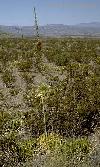 |
Agave lechuguilla | Common Name: Agave
Leaves: 3.5 dm long and 2-3 cm wide, linear, straight to falcate (sickle-shaped) or upcurving Flowers: In clusters of 1-3, ovary greenish-yellow, fusiform (spindle-shaped - thickest near the middle and tapering toward each end), 12-14 mm long, tepals 12-18 mm long, spreading, linear, yellow to red or purplish Fruit: Capsules oblong, 2-3 cm long Habitat: Open arid calcareous rocky slopes Range: West Texas, southern New Mexico, southeast across the Mexican highlands to State of Mexico Group: Monocot Family: Agavaceae Growth Habit: Subshrub/Shrub/Forb/Herb - small widely suckering yellow-green rosettes 2.5-4 dm tall Duration: Perennial U.S. Nativity: Native |
 |
 |
Yucca baccata | Common Name: Banana Yucca, Blue Yucca or Datil
Leaves: Broadened toward the middle, commonly straight or incurved, occasionally twisted, rather deeply concavo-convex, quite rigid, 3-7 dm long and 3.5-5 cm wide Flowers: Campanulate (bell-shaped), pendent, white or cream-colored, commonly tinged with purple Fruit: 7-24 cm long 25-55 mm in diameter, symmetrical, broadly cylindrical or somewhat tapering; seeds to 11 mm flat, thick, rough, dull black Habitat: On rocky hill and mountain slopes and plains of grasslands, juniper and oak woodlands Range: West Edwards Plateau and Trans-Pecos, Texas to California and adjacent Mexico Group: Monocot Family: Agavaceae Growth Habit: Subshrub/Shrub/Forb/Herb - clumped at ground level 1-5 m in diameter, with as many as 70 heads of leaves Duration: Perennial U.S. Nativity: Native |
 |
| Amaranthaceae | Back to index | ||
 |
Amaranthus spinosus | Common Name: Spiny Amaranth or Pigweed
Leaves: Alternate, ovate-lanceolate to ovate, glabrous to sparingly pubescent (covered with short hairs - downy), 3-10 cm long Flowers: Male and female flowers, occasional flowers perfect, spikes numerous, 5-15 cm long Fruit: Black, nearly round, 0.7-1 mm in diameter Habitat: In waste ground, sandy loamy soil Range: East third of Texas, west to Dallas, Travis and Cameron counties Group: Dicot Family: Amaranthaceae Growth Habit: Forb/Herb - weedy, long (to 4 dm taproot), stems stout and succulent, erect, branched, 3-12 dm tall Duration: Annual U.S. Nativity: Probably tropical in origin (Correll and Johnston); Native (USDA) |
 |
| Anacardiaceae | Back to index | ||
 |
Rhus glabra | Common Name: Smooth Sumac or Scarlet Sumac
Leaves: Leaflets 11-31, lanceolate to oblong-lanceolate, to 12 cm long, sharply serrate, glaucous beneath Flowers: Greenish, in a large dense terminal panicle to 25 cm long, puberulous (slightly hairy) Fruit: Scarlet, viscid-pubescent, compressed, ~4 mm in diameter Habitat: On dry sandy hillsides and banks Range: East Texas west to Brazos, Eastland and Armstrong counties; from New England and Quebec south to Florida, Texas, Arizona and northern Mexico Group: Dicot Family: Anacardiaceae Growth Habit: Tree/Shrub - 3 m high, bright autumn foliage and scarlet fruiting panicles Duration: Perennial U.S. Nativity: Native |
 |
| Asteraceae | Back to index | ||
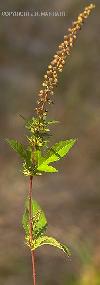 |
Ambrosia trifida | Common Name: Giant Ragweed
Leaves: Alternate or opposite at the lower nodes, in some species opposite nearly throughout, entire or palmately lobed or (usually) pinnately lobed or dissected Flowers: Ray flowers absent, lacking pappus and corolla, phyllaries fused about flowers to form a hard indehiscent nutlike receptacle Fruit: Brown achene ~4 mm Habitat: Abundant in seasonally moist stream bottoms and overflow areas Range: Throughout the eastern and northern halves of Texas; the midwest, and the central United States to the Rocky Mountains and from southern Canada to northern Mexico Group: Dicot Family: Asteraceae Growth Habit: Subshrub/Forb/Herb - tall erect annual taprooted herb 1-3 meters tall, stem angled, striate and scabrous Duration: Annual U.S. Nativity: Native |
 |
 |
Helianthus annuus | Common Name: Sunflower
Leaves: Leaves always opposite at least at the base of the stems and usually alternate above, ovate, obtuse or less commonly acute and coarse-textured Flowers: Disc 3-5 cm across, rays 21-35 are 3-5 cm long and 10-15 mm broad Fruit: A dark achene with white stripes 4-7 mm Habitat: Fields, borders, waste places and gardens Range: Rare in northeast Texas; found in the east and central United States and south Canada Group: Dicot Family: Asteraceae Growth Habit: Forb/Herb - taprooted annual, stems 5-25 dm tall Duration: Annual U.S. Nativity: Native |
 |
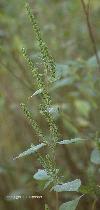 |
Iva annua | Common Name: Annual Marshelder or Sumpweed
Leaves: Alternate or opposite 3-12 cm long, ovate or becoming lanceolate upward Flowers: Staminate flowers 9-17, corolla about 2.5 mm long, pistillate flowers 3-5, corollas about 1.5 mm long Fruit: Achenes 2-4.5 mm long, brown, broadly ovate, lenticular Habitat: Fields, borders, waste places and gardens Range: East half of Texas, west to Wheeler, Taylor, Travis, DeWitt and Hidalgo counties; most of the eastern United States, west to Nebraska, Kansas, Oklahoma and Texas Group: Dicot Family: Asteraceae Growth Habit: Forb/Herb - taprooted 4-20 dm tall Duration: Annual U.S. Nativity: Native |
 |
| Cactaceae | Back to index | ||
 |
Echinocereus enneacanthus | Common Name: Hedgehog Cactus or Pitaya
Leaves: Not discernible, 1-4 central spines per areole, 25-94 mm long; 7-10 radial spines Flowers: On the old growth below the apex of the stem, bursting through the epidermis just abouve the spine-bearing areole; 7.5-12.5 cm in diameter Fruit: Red flesh with deciduous areoles bearing spines, has a fragrant odor and a flavor and texture resembling the strawberry; black seeds strongly tuberculate (covered with tubercles) to pitted, 1-1.4 mm long Habitat: Dry, sandy soils Range: Val Verde to Kimble, Kerr and Cameron counties; also Chihuahua and Tamalupas Group: Dicot Family: Cactaceae Growth Habit: Shrub/Subshrub - stems profusely branching with 120-350 forming clumps up to several dm high and 6-20 dm in diameter; stems cylindroidal Duration: Perennial U.S. Nativity: Native |
 |
 |
Opuntia Lindheimeri engelmannii | Common Name: Texas Prickly Pear or Nopal Prickly Pear
Leaves: Spines in all but the lower areoles, 1-6 per areole Flowers: 5-7.5 cm in diameter; petaloid perianth parts yellow Fruit: Purple, fleshy, obovate or elongate 3.1-7 cm long Habitat: On rocky hill and mountain slopes Range: Texas, New Mexico and Mexico Group: Dicot Family: Cactaceae Growth Habit: Shrub/Subshrub - 1 to 3 m high joints green or blue-green, obovate to orbiculate or rarely elongate, 15-25 cm long Duration: Perennial U.S. Nativity: Native |
 |
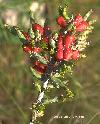 |
Opuntia leptocaulis | Common Name: Tasajillo, Christmas Cactus or Pencil Cholla
Leaves: Spines 1 per areole, 2.5-5 cm long Flowers: Flower 1-1.5 cm in diameter; petaloid perianth parts green to yellow or bronze Fruit: Bright red, fleshy, juicy, tuberculate, obovoid, 2 cm long Habitat: Rocky soils of desert hillsides Range: Southern New Mexico to Texas west of the Pecos River Group: Dicot Family: Cactaceae Growth Habit: Shrub/Subshrub - small with joints of the main branches to 3-4 dm long; cylindroidal; tubercles almost lacking Duration: Perennial U.S. Nativity: Native |
 |
| Chenopodiaceae | Back to index | ||
 |
Chenopodium album | Common Name: Pigweed, Goosefoot, Lamb's-Quarters, or Wild Spinach
Leaves: Oval-rhombic, rarely ovate or lanceolate, 2.5-8 cm long, usually conspicuously longer than broad, obtuse or rounded and apiculate at the apex, often shallowly 3-lobed, pale-green and glabrate above, densely farinose beneath Flowers: Flowers in large glomerules, terminal stout erect or ascending paniculate spikes to 3 dm long, grayish-green Fruit: Black, 1.1-1.5 mm broad, nearly smooth to minutely pitted Habitat: Fields, fencerows and waste places. Range: Newfoundland to Florida, west to Yukon and British Columbia, south to Mexico and South America, also in North Africa Group: Dicot Family: Chenopodiaceae Growth Habit: Forb/Herb - pale-green, sometimes turning reddish, 6-30 dm tall Duration: Annual U.S. Nativity: Eurasian (Correll and Johnston); Native and Introduced (USDA) |
 |
| Cucurbitaceae | Back to index | ||
 |
Citrullus vulgaris | Common Name: Watermelon
Leaves: Ovate to ovate-oblong in out line, to 2 dm long, cordate at base, pinnately deeply divided into 3 or 4 pairs of lobes and these again lobed and toothed Flowers: Small, solitary in the axils, corolla about 4 cm across, rotate, with 5 lobes obovate and obtuse Fruit: Globular or oblong, sometimes to 6 dm long, glabrous, with a green or variously striped hard but not durable rind and sweet juicy red, yellow or greenish flesh; seeds numerous, black, white, or reddish, flat, smooth, to 15 mm long Habitat: Locally abundant in sandy soils in several localities, especially in east and south Texas Range: Native of tropical and warm temerature Africa Group: Dicot Family: Cucurbitaceae Growth Habit: Vine/Forb/Herb - pubescent annual with long-running prostrate leafy stems Duration: Annual U.S. Nativity: Introduced |
 |
 |
Cucurbita foetidissima | Common Name: Buffalo Gourd or Calabacilla Loca
Leaves: Coarse and thick, triangular-ovate, at most shallowly angulate-lobed, broadly rounded to cordate at base, acute to acuminate at apex, growing to at least 3 dm long, nauseously ill-smelling (especially when bruised), grayish-green, rough to touch Flowers: Corolla to 1 dm long, flaring above the middle Fruit: Mostly globose, green with lighter stripes, lemon-yellow when ripe, to 75 mm in diameter Habitat: In sandy or gravelly soils in waste places, especially along roadsides Range: Primarily in the west half of Texas; Missouri and Nebraska south to Texas, Arizona, southern California, and Mexico Group: Dicot Family: Cucurbitaceae Growth Habit: Vine/Forb/Herb - rank growing and rampant, with a frequently huge fusiform perennial root producing numerous widely running stems to 6 m Duration: Annual U.S. Nativity: Native |
 |
 |
Cucurbita maxima | Common Name: Winter Squash
Leaves: Flowers: Large orange-yellow pistillate flowers in leaf axils, staminate flowers on stalks Fruit: Large green to orange Habitat: Well drained, fertile, frost-free soils Range: North America and Caribbean Group: Dicot Family: Cucurbitaceae Growth Habit: Vine/Forb/Herb - sprawling prickly stems, tendrils opposite large leaves Duration: Annual U.S. Nativity: Introduced |
 |
 |
Cucurbita moschata | Common Name: Field Pumpkin, Butternut Squash, Seminole Pumpkin, or Crookneck Squash
Leaves: Flowers: Large orange-yellow pistillate flowers in leaf axils, staminate flowers on stalks Fruit: Large green to orange Habitat: Well drained, fertile, frost-free soils Range: North America and Caribbean Group: Dicot Family: Cucurbitaceae Growth Habit: Vine/Forb/Herb - Duration: Annual U.S. Nativity: Introduced |
 |
 |
Lagenaria siceraria - A monotypic genus | Common Name: Bottle Gourd or White-Flowered Gourd
Leaves: Ovate to ovate-reniform and cordate-based, 15-30 cm wide, usually not lobed, margins apiculate-dentate Flowers: On long peduncles and commonly surpassing the leaves, anthers only slightly coherent Fruit: To 3 dm long or more, varying from disk-shaped to nearly globular and bottle-shaped, dumbell-shaped, club-shaped, crooknecked or coiled, with a hard usually greenish or tan but sometimes striped or mottled durable shell, occasionally knobby or ridged; seeds tan to brown, ridged on the margins and cornered, oblong to squarish Habitat: In sandy or gravelly soils in waste places, especially along roadsides Range: Old world origin, but cultivated throughout the world, sometimes spontaneous in east and south Texas Group: Dicot Family: Cucurbitaceae Growth Habit: Vine/Forb/Herb - musky-scented soft viscid-pubescent monoecous (staminate and pistillate flowers on same plant) or rarely dioecious (staminate and pistillate flowers on different plant) annual vine with branched tendrils Duration: Annual U.S. Nativity: Introduced |
 |
| Fabaceae | Back to index | ||
 |
Acacia greggii | Common Name: Catclaw Acacia, Catclaw, Devilsclaw, Gregg Catclaw, or Texas Catclaw
Leaves: Pinnae 1-3 pairs; leaflets 3 to 7 pairs, mostly 3-6 mm long, obovate to narrowly oblong, usually pallid-green, obtuse Flowers: Creamy-white, in spikes about 1 cm thick and 2-6 times as long as thick; Fruit: Pods flat, thin, usually falcate 5-8 cm long, 15-20 mm broad, only very late becoming rigid, brownish; seeds small and flat, not causing the pod to bulge Habitat: Frequent in brushy vegetation Range: Trans-Pecos and Rio Grande Plains, northeast as far as Taylor and Coleman counties; southern United States and northern Mexico Group: Dicot Family: Fabaceae Growth Habit: Tree/Shrub - usually not more than 1-2 m tall, rounded and muched branched, formidably armed with recurved catclaw-like prickles Duration: Perennial U.S. Nativity: Native |
 |
 |
Medicago sativa | Common Name: Alfalfa
Leaves: Leaflets 1-3 cm long 3-8 mm broad, obovate to oblong or oblanceolate Flowers: Racemes crowded, 1-4 cm long, 1-2 cm thick, with 10 to 20 flowers; petals 7-12 mm long, violet-blue Fruit: Pod loosely and spirally coiled in 1 or 2 turns, the coils about 4-5 mm in diameter, prickless Habitat: Widespread as an escape along roadsides and in abandoned fields Range: In Texas absent in only the Rio Grande Plains and Coastal Bend regions; very widely distributed as a forage crop and as a weed Group: Dicot Family: Fabaceae Growth Habit: Forb/Herb - 3 to 10 dm tall Duration: Perennial U.S. Nativity: Introduced |
 |
 |
Phaseolus acutifolius | Common Name: Tepary Bean
Leaves: Leaflets linear to lanceolate, sharply acute, 3-8 times as long as broad, rarely or perhaps never lobed Flowers: 2 to 4 (sometimes 1) per inflorescence, 8-10 mm long at anthesis; calyx pubescent, about 4 mm long subequally 5-lobed, corolla creamy-blue to lavender; Fruit: Pods curvilinear, 4-7 cm long Habitat: Rare in canyons, Trans-Pecos mountains, 4,000-6,000 feet in elevation Range: Texas, New Mexico, Arizona Group: Dicot Family: Fabaceae Growth Habit: Vine/Forb/Herb - slender taproot Duration: Annual U.S. Nativity: Native |
 |
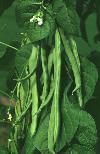 |
Phaseolus vulgaris | Common Name: Navy or Pea Bean, Red Kidney, Pinto, Great Northern, Marrow, and Yellow Eye Bean
Leaves: Alternate, petiolate, and once-pinnately-trifoliate Flowers: Racemes axillary, ascending, long-pedunculate Fruit: Linear, slightly laterally compressed Habitat: Range: North America and Caribbean Group: Dicot Family: Fabaceae Growth Habit: Vine/Forb/Herb Duration: Annual U.S. Nativity: Introduced |
 |
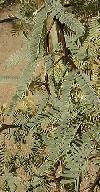 |
Prosopis juliflora | Common Name: Mesquite
Leaves: Pinnae usually 1 pair per leaf, leaflets widely spaced, usually 6-15 pairs per pinna, foliage usually glabrous Flowers: In spikes or heads, yellow or creamy-white Fruit: Essentially straight, several seeded pod, nearly as thick as broad 7-20 cm long; seeds partitioned from each other and essentially embedded in fleshy parenchyma; probably the commonest "legume" in Texas Habitat: Especially abundant on disturbed grasslands Range: Abundant in the Rio Grande Plains, parts of north-central and southeast Texas, and Plains Country, scattered in the Trans-Pecos, east Texas and Edwards Plateau; in Kansas, Oklahoma, and east New Mexico, south into Mexico Group: Dicot Family: Fabaceae Growth Habit: Tree/Shrub - small Duration: Perennial U.S. Nativity: Introduced |
 |
 |
Prosopis velutina | Common Name: Velvet Mesquite
Leaves: Leaflets are generally short, hairy, and closely spaced; as opposed to those of honey mesquite which are long, linear, glabrous and widely spaced; Flowers: In spikes or heads, yellow or creamy-white Fruit: seeds are glossy brown, oval, 5-7 (mm0.2 to 0.28 inch) long and 4-5 (mm0.12 to 0.2 inch) wide Habitat: Velvet mesquite occurs in low elevation vegetation area, in desert grasslands, along major water coarses and their tributaries, deciduous woodlands or "bosques" are often dominated by velvet mesquite Range: A small, isolated population occurs in the Rio Grande Valley, near El Paso, Texas, thought to be introduced; the main distribution is confined to central and southern Arizona, extreme southwestern New Mexico, and adjacent northern Mexico; the Continental Divide forms a natural boundary between populations of velvet mesquite and honey mesquite; in California, velvet mesquite is represented by only a few individuals that occur in Imperial, Riverside, and Kern counties and is believed to be from human introductions Group: Dicot Family: Fabaceae Growth Habit: Tree/Shrub - a deciduous, thorny shrub or small tree, may grow into single-stemmed trees up to 15 m (50 feet) tall with a trunk diameter up to about 61 cm (2 feet) or they may develop into an erect, multistemmed bush Duration: Perennial U.S. Nativity: Native |
 |
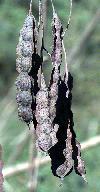 |
Sesbania drummondii | Common Name: Rattlebush, Poison Bean, or Coffee Bean
Leaves: Mostly 1-2 dm long; leaflets 20-50 mostly 15-35 mm long and 4-7 mm broad Flowers: 13-16 mm long yellow, often with red lines Fruit: 5-6 cm long about 1 cm broad; the seeds are loose in the mature pods which rattle when the bush is in motion; known to be poisonous to sheep and goats Habitat: In disturbed areas and wastelands Range: Coastal Plain inland to Denton, Williamson, Travis, Comal, Wilson, McMullen and Starr counties in Texas; Louisiana, Mississippi, Alabama, Florida, Arkansas Group: Dicot Family: Fabaceae Growth Habit: Subshrub/Shrub - in the northern regions the branches often die back during the winter, only the lowest part of the plant remaining alive and becoming woody, 4-30 dm tall Duration: Perennial U.S. Nativity: Native |
 |
 |
Sophora secundiflora | Common Name: Texas Mountain Laurel, Mescal Bean or Frijolillo
Leaves: Leaflets very firm, 5 to 11 per leaf, often 17 mm broad or broader and glabrous above Flowers: Racemes 5-15 cm long and 5-10 cm broad, bluish-purple and very showy, the individual flowers 1-2 cm long Fruit: Woody pods 2-12 cm long and 1 mm thick or thicker, moderately constricted between the seeds; seeds red Habitat: Frequent in brushy vegetation Range: South edge of Edwards Plateau north to Travis county and in the caliche areas in the Rio Grande Plains, scattered in west part of Edwards Plateau and Trans-Pecos mountains in Texas; west to New Mexico Group: Dicot Family: Fabaceae Growth Habit: Tree/Shrub - evergreen, 5-35 dm tall, usually with dense glossy foliage Duration: Perennial U.S. Nativity: Native |
 |
| Fagaceae | Back to index | ||
 |
Quercus stellata | Common Name: Post Oak
Leaves: Deciduous, thick, hard and membranous, usually about 8 cm long and 6 cm broad, obovate to elliptic or obtriangular in outline apices rounded, bases cuneate to cordate, undulately or deeply 2-4 lobed on each side, upper surface is lustrous and glabrous except for the sprinkling of minute stellate hairs, lower surface dull, more densely stellate-pubescent or glabrate, quite glaucous Flowers: Staminate catkins 5-8 cm long, rather loosely flowered; pistillate catkins 3-10 cm long Fruit: Solitary or paired, moderate size or rarely large, cups 12-25 mm broad and 18 mm high, cup-shaped or sometimes goblet-shaped, cup scales oblong to triangular-ovate; acorns to 3 cm long and 18 mm broad Habitat: Dry upland woods, frequently on sandy soil Range: Central Texas; and north to Kansas, and most of the eastern United States Group: Dicot Family: Fagaceae Growth Habit: Tree - moderate size tree Duration: Perennial U.S. Nativity: Native |
 |
| Juglandaceae | Back to index | ||
 |
Carya illinoinensis | Common Name: Pecan
Leaves: Leaves to 5 dm long, leaflets 9-17, oblong-lanceolate to lanceolate, the margin coarsely and often doubly serrate, to 2 dm long and 75 mm wide, dark yellow-green and glabrous above and pale and glabrous or pubescent beneath, the terminal leaflet only slightly broader than uperr lateral ones Flowers: Staminate Fruit: Clusters of 3-11, ovoid to ellipsoid, pointed at apex, rounded at the base Habitat: Low rich grounds along streams, bottomlands and moist open woodlands Range: Central and northwest Texas; and most of the eastern United States Group: Dicot Family: Juglandaceae Growth Habit: Tree - about 50 m high, with a massive trunk to 2 m in diameter that is often enlarged and buttressed at the base Duration: Perennial U.S. Nativity: Native |
 |
| Passifloraceae | Back to index | ||
 |
Passiflora affinis | Common Name: Passion Vine
Leaves: Glabrous; 2-10 cm long and 3-14 cm wide, usually lobed from a half to two thirds their length, cordulate or subtruncate at base, 3-nerved Flowers: Calyx tube campanulate to cylindric; corona of 1 to several series of distinct or more or less united filaments rarely tubular Fruit: Subglobose, glabrous, 8-10 mm long, purplish-black; seeds numerous, obcordate, about 3 mm long and 2 mm wide, transversely sucate, the grooves 6 or 7 Habitat: Limestone areas Range: Edwards Plateau in Texas and northern Mexico Group: Dicot Family: Passifloraceae Growth Habit: Vine/Forb/Herb Duration: Perennial U.S. Nativity: Native |
 |
| Poaceae | Back to index | ||
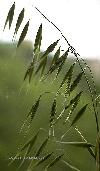 |
Avena sativa | Common Name: Oats, Wild Oats, Oatgrass
Leaves: Short awns and hairy lemmas Flowers: Spikelets slightly laterally compressed with 2 perfect florets Fruit: Grain Habitat: Disturbed areas Range: East, southeast and north-central Texas, also the Edwards Plateau; North America Group: Monocot Family: Poaceae Growth Habit: Graminoid - tufted, culms 40-75 mm long, panicles open and diffuse 15-25 cm long and 3-10 cm broad Duration: Annual U.S. Nativity: Introduced |
 |
 |
Zea diploperennis | Common Name: Teosinte or Diploperennial Teosinte
Leaves: Broad flat leaves Flowers: Both pistillate and staminate spikelets borne on the same plant Fruit: Grain Habitat: Range: In very limited regions of highlands of Western Mexico Group: Monocot Family: Poaceae Growth Habit: Graminoid Duration: Perennial U.S. Nativity: Introduced |
  |
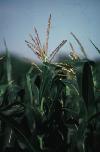 |
Zea mays | Common Name: Indian Corn
Leaves: Broad flat leaves Flowers: Pistillate spikelets borne in several rows on a much-thickened cylindrical rachis (cob), the whole inflorescence covered with usually modified leaves (shucks) and the entire "ear" marked at the end by the termini of elongated styles (silk); Staminate spikelets borne in pairs on the spike-like racemes at the top of the plant Fruit: Grain Habitat: Incapable of survival outside of cultivation Range: Texas, and much of the United States Group: Monocot Family: Poaceae Growth Habit: Graminoid - Robust annual Duration: Perennial U.S. Nativity: Introduced |
 |
| Pinaceae | Back to index | ||
 |
Pinus cembroides | Common Name: Mexican Piņon Pine
Leaves: Needles 3, sometimes 2, in a bundle, 25-45 mm long slender, dark-bluish green; bundle sheath about 5 mm long Flowers: Staminate flowers Fruit: Cones ovoid, 2.5-4 cm long, reddish-brown, with thick blunt scales; seeds brown, hard shelled, usually about 1 cm long Habitat: Mesas and mountain slopes Range: South half of Trans Pecos, Texas; west to southeast Arizona and New Mexico Group: Gymnosperm Family: Pinaceae Growth Habit: Tree - to 10 m or more tall, with a trunk 5 dm or more in diameter Duration: Perennial U.S. Nativity: Native |
 |
| Polygonaceae | Back to index | ||
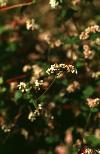 |
Fagopyrum esculentum | Common Name: Buckwheat
Leaves: Flowers: Fruit: Habitat: Range: Group: Dicot Family: Polygonaceae Growth Habit: Forb/Herb Duration: Annual U.S. Nativity: Introduced |
 |
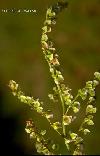 |
Rumex occidentalis | Common Name: Dock
Leaves: Alternate, flat undulate or crisped, narrowed to cordate or auricled at base Flowers: Greenish on pedicels that are jointed to and terminate short peduncles Fruit: Greatly increasing in size compared to their size at anthesis and erect and usually loosely coherent to the achene; ovary sessile; achene trigonous Habitat: Range: North America Group: Dicot Family: Polygonaceae Growth Habit: Forb/Herb - Duration: Annual U.S. Nativity: Introduced |
 |
| Sapindaceae | Back to index | ||
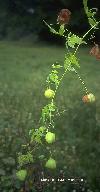 |
Cardiospermum halicacabum | Common Name: Heartseed or Balloon Vine
Leaves: Alternate, biternate; leaflets ovate-lanceolate to rhombic-lanceolate or narrowly lanceolate, acuminate at apex, incisely lobed and toothed, to about 8 cm long and 3 cm wide Flowers: About 4 mm long; petals obovate yellowish or whitish, racemose-paniculate or corymbose clusters Fruit: Membranaceous 3-lobed 3-celled inflated pod 3-4.5 cm in diameter; seeds black, 5 mm in diameter, cordate scar gives this plant its name Habitat: Sprawling over ground and trailing over weeds and bushes in open waste ground or brushy areas in northeast, central, and south Texas; widespread in warmer regions of the Western Hemisphere Range: Texas; most of the eastern United States Group: Dicot Family: Sapindaceae Growth Habit: Vine/Subshrub/Forb/Herb - stem wiry, several-ribbed Duration: Annual/Biennial/Perennial U.S. Nativity: Native |
 |
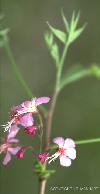 |
Ungnadia speciosa | Common Name: Mexican Buckeye or Texas Buckeye
Leaves: Leaflets 3-7, ovate to ovate-lanceolate, acuminate, serrate, to 12 cm long and 4 cm wide, pubescent beneath when young but soon glabrate Flowers: Lateral fascicles, appearing before or with the leaves from the axils of the preceding season, pink to purplish-pink, fragrant; calyx deeply 5-lobed; petals 4 or 5, obovate, 7-10 cherry red stamens Fruit: Large somewhat woody stipitate 3-lobed smoothish pod, pale-green, often suffused with red, 3.5-5 cm thick; seeds spherical, 1-1.5 cm in diameter, dark-brown to blackish, poisonous Habitat: In rocky areas in canyons and on slopes and ridges Range: in south, central, and west Texas, east to Dallas county; in New Mexico and Mexico Group: Dicot Family: Sapindaceae Growth Habit: Tree - rarely 10 m high with a trunk 2 dm in diameter Duration: Perennial U.S. Nativity: Native |
 |
| Solanaceae | Back to index | ||
 |
Capsicum annuum | Common Name: Chile Pepper or Cayenne Pepper
Leaves: Alternate, ovate to elliptic-lanceolate or lanceolate, acute to acuminate to 6 cm long and 3 cm wide Flowers: Corolla stellate, whitish, about 7 mm wide Fruit: Berry is ovoid to nearly globose, persistent, red or yellowish, to about 15 mm long pungently aromatic Habitat: On ledges along rivers, in thickets, groves and along arroyos Range: Edwards Plateau to south Texas; east to Florida and west to Arizona; throughout tropical America Group: Dicot Family: Solanaceae Growth Habit: SubShurb/Shrub/Forb/Herb - slender divergent brittle green branches to 3 m high Duration: Annual/Perennial U.S. Nativity: Native/Introduced |
 |
 |
Datura stramonium | Common Name: Jimsonweed, Jamestown Weed or Datura
Leaves: Ovate to elliptic, to 2 dm long sinuately to lanciniately lobed Flowers: Calyx 35-45 mm long the unequeal teeth 5-10 mm long, corolla white, commonly timged with lavender, 6-8 cm long Fruit: Capsule erect, ovaoid 3.5-5 cm long usually armed with spines mostly less than 5 mm long finely and sparsely puberulent to glabrate; seeds black, rugulose and finely pitted Habitat: In cultivated areas and waste places throughout Texas; widely distributed through the world Range: United States except Alaska and Wyoming Group: Dicot Family: Solancacea Growth Habit: Forb/Herb/Subshrub - simple to spreading branched erect to 15 dm high, with green sparsely puberulent to glabrate stems and foliage Duration: Annual U.S. Nativity: Introduced |
 |
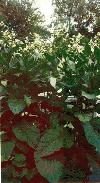 |
Nicotiana rustica | Common Name: Aztec tobacco or Wild Tobacco
Leaves: Entire or sometimes repand or panduriform Flowers: Racemes or panicles; calyx tubular-campanulate, 5-cleft; corolla funnelform or salverform, usually with a long tube Fruit: Capsule ovoid to narrowly ellipsoid, acute or blunt 2-celled, 2-4 valved from the apex; seeds numerous and minute Habitat: Range: Group: Dicot Family: Solanaceae Growth Habit: Forb/Herb - narcotic-poisonous and heavy-scented, usually viscid-pubescent Duration: Annual U.S. Nativity: Probably Introduced |
 |
 |
Solanum lycopersicum formerly Lycopersicon esculentus | Common Name: Tomato
Leaves: Odd-pinnate, with small interstitial petiolulate leaflets, to about 4 dm long; primary leaflets 5-9, stalked, ovate to oblong, to 75 mm long, acuminate, irregularly incised or toothed, the margins tending to roll inward Flowers: 3-7 nodding, to about 2 cm across or more, on jointed pedicels that are reflexed in fruit; calyx 5-parted to base, the lanceolate lobes to 1 cm long; corolla yellow, the 5 lanceolate lobes recurved-reflexed, a little more than 1 cm long Fruit: Pulpy berry, red or yellow, usually flattend at the ends, to 75 mm across, the sides often furrowed or angled; seeds numerous Habitat: Range: Native of western South America; cultivated elsewhere for it's fruit Group: Dicot Family: Solanaceae Growth Habit: Forb/Herb - spreading hairy-pubescence and more or less glandular and strong-smelling, to 15 dm high or more, the young growth on mature plants erect Duration: Annual/Perennial U.S. Nativity: Introduced - Native to the warmer parts of AMerica |
 |
| Ulmaceae | Back to index | ||
 |
Celtis laevigata var. Texana | Common Name: Texan Sugarberry, Hackberry, or Palo Blanco
Leaves: Entire to somewhat serrate, thin and membranaceous to coriaceous, uniformly pale-green on both surfaces, with conspicuous veins, lanceolate to oblong-lanceolate or sometimes ovate-lanceolate, typically long-acuminate apex commonly prolonged and curving at the tip, leaves of fruiting branches less than half as broad as long, 4-10 cm long 15-45 mm broad Flowers: Appearing with the leaves on the young branchlets; staminate flowers in fascicles towards the base; perfect flowers above, solitary in the axils of the leaves; calyx 5-lobed Fruit: Drupes subspherical, 5-8 mm in diameter, beakless, orange to brown or red, on pedicels 6-15 mm long; stone 4.5-7 mm long and 5-6 mm broad Habitat: Sandy loam, rocky soil or alluvial soil along streams in woodlands, palm groves and thickets Range: In the east two thirds of Texas, west to Hardeman, King and Val Verde counties, south to Cameron county; from Florida to Oklahoma and north to Virginia, Illinois, Missouri, and Kansas; also in northeast Mexico Group: Dicot Family: Ulmaceae Growth Habit: Tree/Shrub - to 30 m high, with spreading often pendulous branches to form a broad crown Duration: Perennial U.S. Nativity: Native |
 |
| Vitaceae | Back to index | ||
 |
Vitis mustangensis | Common Name: Mustang Grape
Leaves: Broadly triangular-ovate to ovate-reniform, subacute to obtuse at apex, 6-14 cm long from top of petiole, about as wide as - or wider than - long, white-tomentose (felty) on both sides when young, later dark-green and glabrous or somewhat floccose on upper side and permanently white-tomentose on lower surface Flowers: Thyrse 5-12 cm long Fruit: 1.5-2 cm, thick, purple black, tough skin, fiery disagreeable taste, 2 celled with 2-4 seeds; seeds are 6-7 mm long and 6-7 mm broad, usually pyriform (pear-shaped) with a beaklike base and 2 grooves on the ventral side Habitat: Along stream bottoms, thickets, fence rows, edges of woods, sandy slopes Range: East half of Texas; Oklahoma, Arkansas, Louisiana, Alabama Group: Dicot Family: Vitaceae Growth Habit: Vine Duration: Perennial - shrubs or vines with watery acid juice, usually climbing by tendrils opposite the leaves U.S. Nativity: Native |
 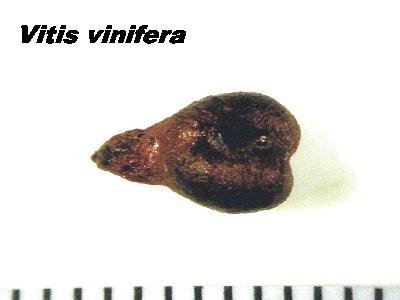 |